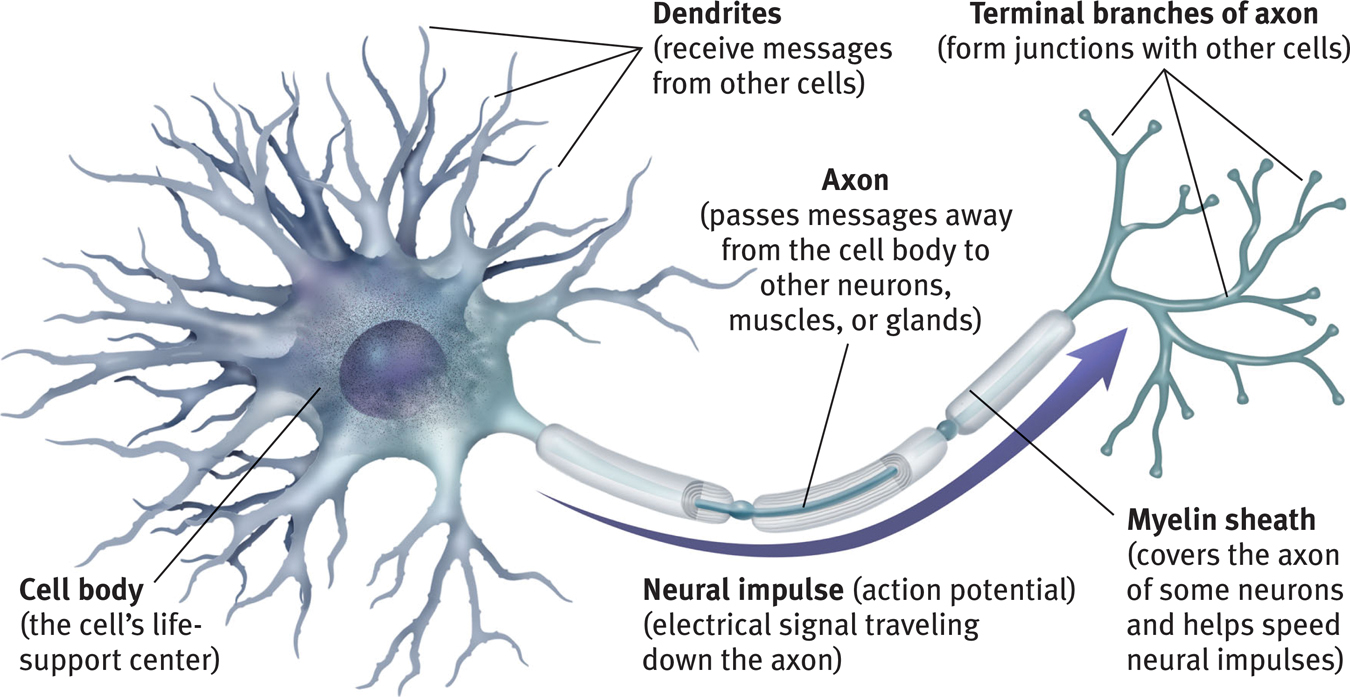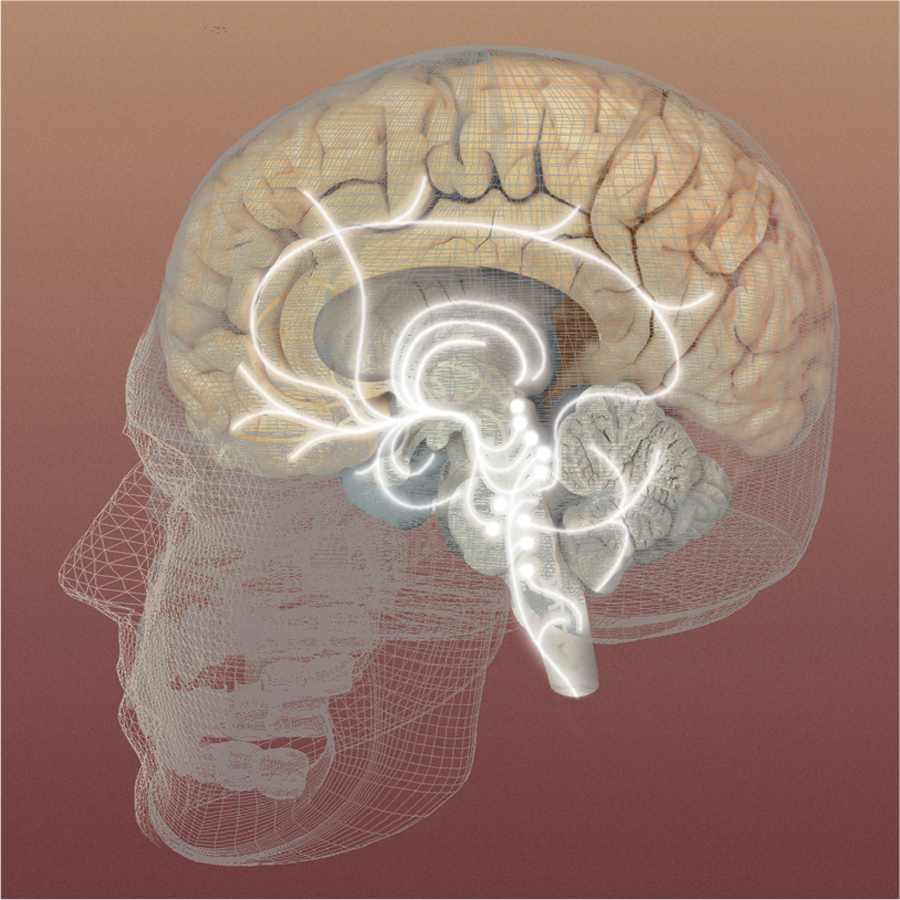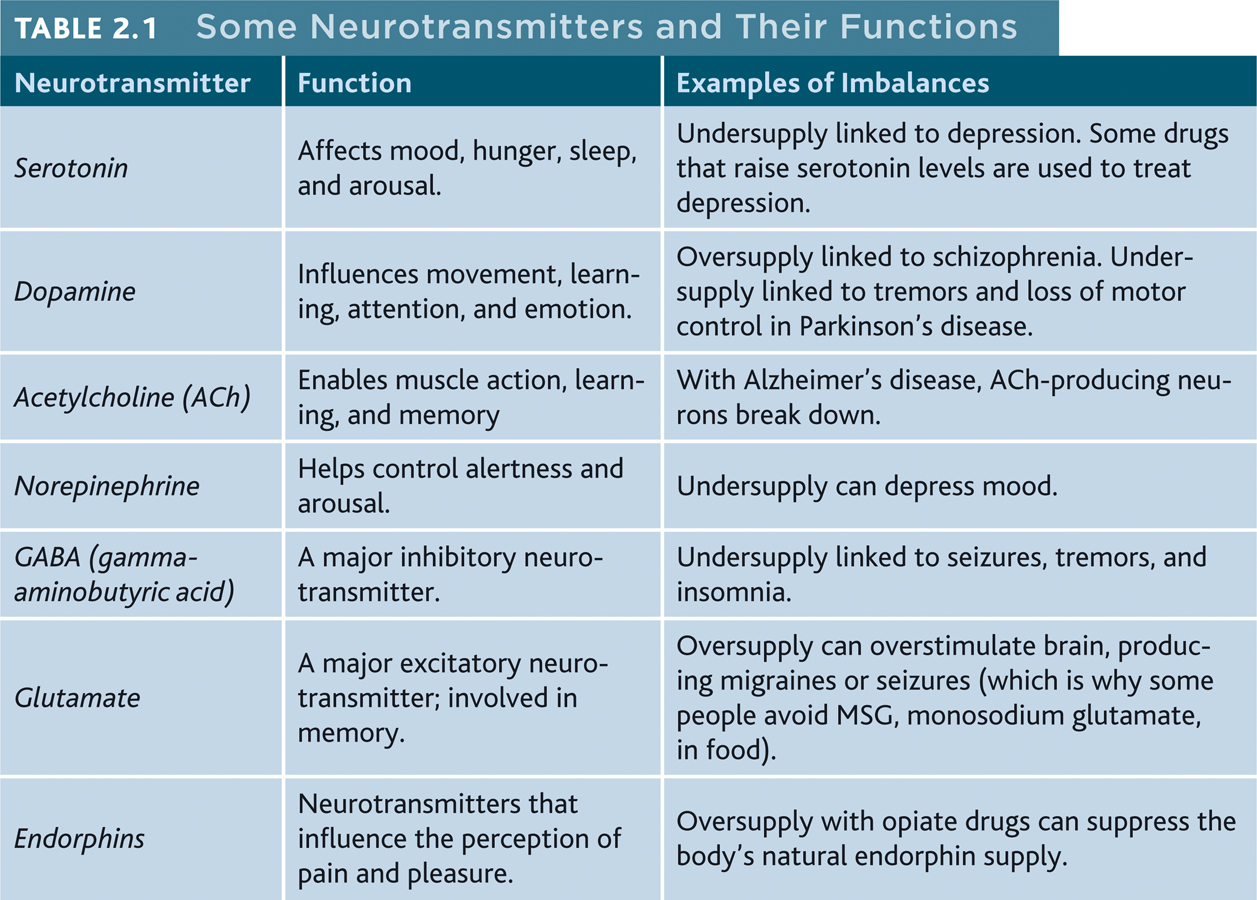Neural Communication

The human body is complexity built from simpler components. Part of this complexity is our amazing internal communication system. Around the world, researchers are unlocking the mysteries of how our brain uses electrical and chemical processes to take in, organize, interpret, store, and use information. The story begins with the nervous system’s basic building block, the neuron, or nerve cell. We’ll look first at its structure, and then at how neurons work together.
A Neuron’s Structure
2-2 What are the parts of a neuron?
Neurons differ, but each consists of a cell body and its branching fibers (Figure 2.1). The neuron’s bushy dendrite fibers receive messages and conduct them toward the cell body. From there, the cell’s axon fiber sends out messages to other neurons or to muscles or glands. Dendrites listen. Axons speak.

“All information processing in the brain involves neurons ‘talking to’ each other at synapses.”
Neuroscientist Solomon H. Snyder, 1984
The messages that neurons carry are nerve impulses called action potentials. These electrical signals travel down axons at different speeds. Messages travel faster along axons that are covered in a layer of fatty tissue called a myelin sheath. Supporting our billions of nerve cells are nine times as many spidery glial cells (“glue cells”). Neurons are like queen bees; on their own they cannot feed or sheathe themselves. Glial cells are worker bees. They provide nutrients and insulating myelin. They guide neural connections and clean up after neurons send messages to one another. Glia may also play a role in information transmission, thinking, learning, and memory (Fields, 2009; Miller, 2005).
Researchers have tracked some action potentials trudging along at a sluggish 2 miles per hour, and others racing along at 200 or more miles per hour. Can you guess which reacts faster, a human brain or a high-speed computer? The computer wins every time. Even our brain’s top speed is 3 million times slower than electricity zipping through a wire. Thus, unlike the nearly instant reactions of a computer, your “quick” reaction to a sudden event, such as a child darting in front of your car, may take a quarter-second or more. Your brain is vastly more complex than a computer, but slower at executing simple responses. And your reflexes would be slower yet if you were an elephant. The round-trip time for a message that begins with a yank on an elephant’s tail and then travels to its brain and back to the tail is 100 times longer than in the body of a tiny shrew (More, 2010).
Neurons interweave so tightly that even with a microscope you would have trouble seeing where one ends and another begins. But end they do, at meeting places called synapses. At these points, two neurons are separated by a tiny gap less than a millionth of an inch wide. “Like elegant ladies air-kissing so as not to muss their makeup, dendrites and axons don’t quite touch,” noted poet Diane Ackerman (2004). How then does a neuron send information across the tiny synaptic gap? The answer is one of the important scientific discoveries of our age. 
31
RETRIEVE + REMEMBER
Question 2.1
What is the branch of psychology that studies the links between behavior and biology?
biological psychology
Question 2.2
When a neuron fires an action potential, the information travels through the axon, the dendrites, and the cell body, but not in that order. Place these three structures in the correct order.
dendrites, cell body, axon
How Neurons Communicate
2-3 How do neurons communicate?
Each neuron is itself a miniature decision-making device, reacting to signals it receives from hundreds, even thousands, of other neurons. Most of these signals are excitatory, somewhat like pushing a neuron’s gas pedal. Others are inhibitory, more like pushing its brake.
If the excitatory signals exceed the inhibitory signals by a minimum intensity, or threshold, the combined signals trigger an action potential. (Think of it this way: If the excitatory party animals outvote the inhibitory party poopers, the party’s on.) The neuron then fires, sending an impulse down its axon, carrying information to another cell.
A neuron’s firing doesn’t vary in intensity. The neuron’s reaction is an all-or-none response. Like guns, neurons either fire or they don’t. How, then, do we distinguish a big hug from a gentle touch? A strong stimulus (the hug) can trigger more neurons to fire, and to fire more often. But it does not affect the action potential’s strength or speed. Squeezing a trigger harder won’t make a bullet bigger or faster.
When the action potential reaches the axon’s end, your body performs an amazing trick. Your neural system converts an electrical impulse into a chemical message. At the synapse, the impulse triggers the release of neurotransmitter molecules, chemical messengers that can cross the synaptic gap (Figure 2.2). Within one 10,000th of a second, these molecules bind to receptor sites on the receiving neuron, as neatly as keys fitting into locks. They act as excitatory or inhibitory signals, and the process begins again in this new cell. In a final step, called reuptake, the sending neuron absorbs any leftover neurotransmitters in the synapse. 

RETRIEVE + REMEMBER
Question 2.3
How does our nervous system allow us to experience the difference between a slap and a tap on the back?
Stronger stimuli (the slap) cause more neurons to fire and to fire more frequently than happens with weaker stimuli (the tap).
Question 2.4
What happens in the synaptic gap?
Neurons send neurotransmitters (chemical messengers) across this tiny space between one neuron’s terminal branch and the next neuron's dendrite or cell body
32
How Neurotransmitters Influence Us
2-4 How do neurotransmitters affect our mood and behavior?
Dozens of different neurotransmitters have their own pathways in the brain. As they travel along these paths, they carry specific but different messages that influence our behavior and emotions. Serotonin levels, for example, can make us more or less moody, hungry, sleepy, or aroused. Dopamine levels influence our movement, learning, attention, and emotions. TABLE 2.1 outlines the effects of these and other neurotransmitters.

In Chapter 1, I promised to show you how psychologists play their game. Here’s an example. An exciting neurotransmitter discovery emerged when researchers attached a radioactive tracer1 to morphine, an opiate drug that elevates mood and eases pain (Pert & Snyder, 1973). They noticed that the morphine was binding to receptors in brain areas linked with mood and pain sensations. Why would these natural “opiate receptors” exist in the brain? Why would the brain have these chemical locks, unless our body produced some natural key to open them? Could the brain have its own built-in painkillers?
Further work revealed the answer. The brain does indeed produce its own natural opiates. Pain and vigorous exercise trigger the release of several types of neurotransmitter molecules similar to morphine. These endorphins (short for endogenous [produced within] morphine), as we now call them, help explain why we sometimes seem unaware of pain following extreme injuries. They also explain good feelings, such as the “runner’s high” and the painkilling effects of acupuncture.
If our natural endorphins lessen pain and boost mood, why not achieve these ends by flooding the brain with artificial opiates? One problem is that when flooded with artificial opiates, such as heroin and morphine, the brain may shut down its own “feel-good” chemistry. If the drugs are then withdrawn, the brain will be deprived of any form of relief. Nature charges a price for suppressing the body’s own neurotransmitter production.
33
The biology-of-mind story is woven throughout this book. You will hear more about neurotransmitters in later chapters. 
RETRIEVE + REMEMBER
Question 2.5
The endorphins, serotonin, and dopamine are all chemical messengers called________________.
neurotransmitters
